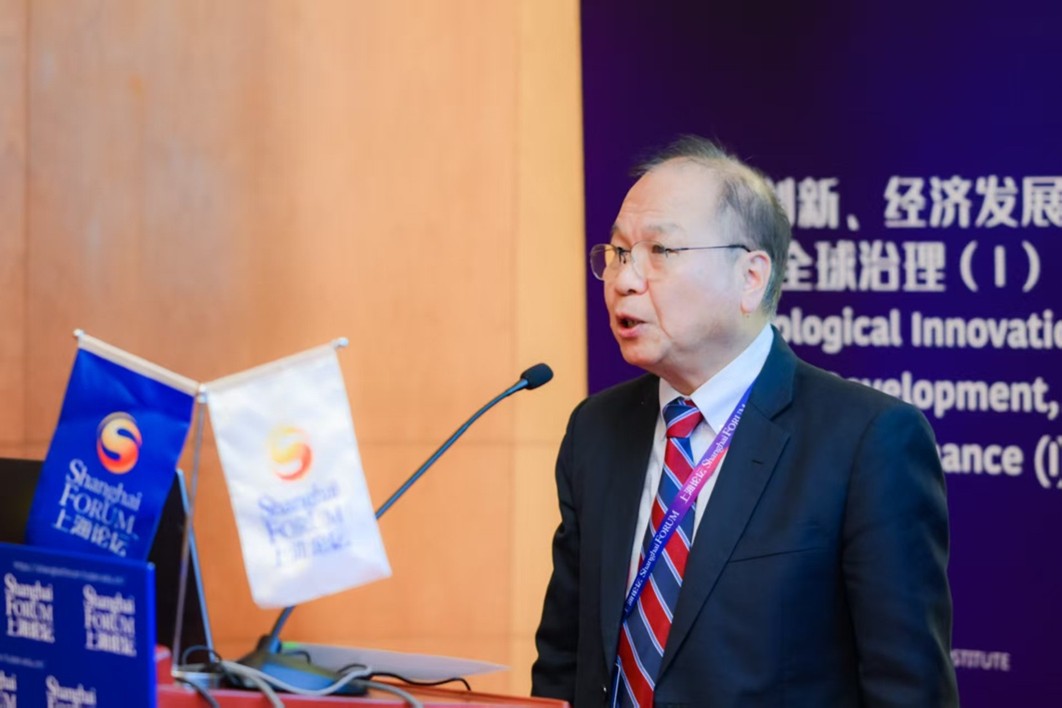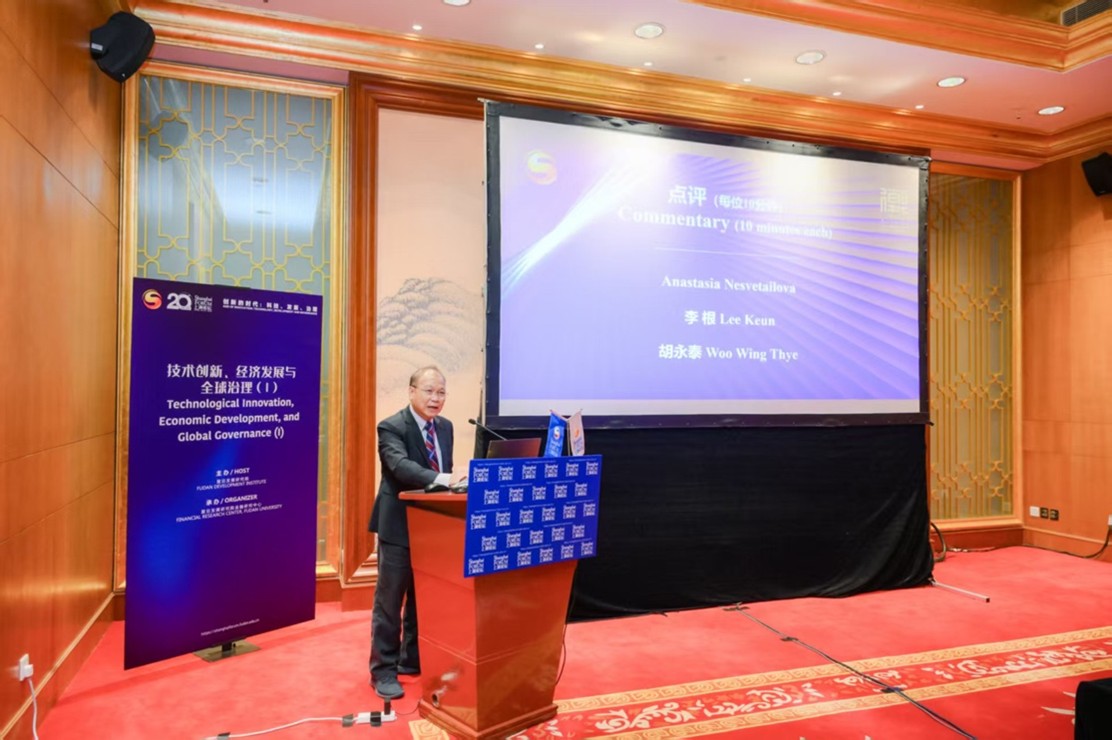The Shanghai Forum 2025 annual conference was held in Shanghai from April 25 to 27. Centered on the theme of ‘An Era of Innovation: Technology, Development, and Governance’, the forum brought together more than 500 guests and representatives from think tanks, universities, government agencies, enterprises, and media organizations across over 50 countries and regions. Participants engaged in in-depth discussions on shared global challenges and contributed insights toward building a more inclusive and equitable path for development in Asia and around the world.
Professor Yu Miaojie (President of Liaoning University) and Professor Woo Wing Thye (University Chair Professor at the China Institute for Economic Research of Liaoning University) were invited to deliver keynote speeches at the 2025 Shanghai Forum. Both members of Liaoning University (LNU) shared their insights on global governance and economic development, focusing on the challenges of a multipolar world.
The following is a summary based on Professor Woo's remarks.

On April 2, 2025, the global trade architecture effectively collapsed when the United States imposed a 145% reciprocal tariff targeting only China. This unprecedented measure underscored the essence of the U.S. deglobalization effort: to ‘punish’ China. As anticipated, Donald Trump framed this as a geopolitical masterstroke, declaring victory in what has become Cold War 2.0. Yet, history consistently demonstrates that trade wars between near-equal powers inflict great mutual harm.
Adam Smith’s lesser-known insight in The Wealth of Nations (1776) cautioned that while free trade promotes shared prosperity, the first three centuries of globalization overwhelmingly benefited Europe. The Americas were ravaged by imported diseases and Asia endured waves of imperial pillage. Smith, however, foresaw a reversal: globalization, through its inherent dissemination of knowledge, would empower formerly colonized nations to reach parity with the West.
This transition is both painful and prolonged. China’s century-long national humiliation reflects the deep costs involved in crossing this ‘valley of tears’ toward modernity. Nonetheless, the successful convergence of formerly marginalized nations has laid the foundation for a multipolar world. This emerging order introduces systemic tensions that require institutional responses. These include the Thucydides Trap, concerning the risk of war between rising and established powers; the Kindleberger Trap, regarding the insufficient supply of global public goods; and the Tragedy of the Commons, referring to the threat of ecological collapse.
A bipartisan consensus in the United States has now formed around the inevitability of China’s rise. Despite Biden’s emphasis on ‘U.S. primacy’ and Trump’s ‘America First’, both know that China’s economic and technological strength will likely exceed that of the United States within the next decade or so unless China’s progress is somehow delayed.
Tensions between the two superpowers have intensified across three interconnected domains: trade, technology, and geopolitical strategy. Rather than pursuing full economic decoupling, the more effective approach is to compartmentalize these three areas of competition. Arms limitation negotiations could manage strategic rivalry. Disputes in the technological domain, particularly over the use of industrial policy, could be addressed through a new World Trade Organization protocol governing the scope and duration of such measures. For successful Sino-US negotiations on these two issues there must be a foundation of mutual trust, which is currently lacking.
When tensions remain moderate, both the United States and China are incentivized to cultivate allies by offering economic benefits. This form of competitive gift-giving is manifested in expanded market access through trade agreements and increased development assistance via initiatives such as the Belt and Road Initiative (BRI) and the G7’s Partnership for Global Infrastructure and Investment (PGII). The proliferation of overlapping trade frameworks, including Regional Comprehensive Economic Partnership (RCEP), Comprehensive and Progressive Agreement for Trans-Pacific Partnership (CPTPP), and Indo-Pacific Economic Framework (IPEF), reflects this strategic outreach.
In such an environment, middle powers encounter both opportunities and risks. While they gain leverage as recipients of economic benefits, they also face the danger of being drawn into major power competition.

For middle powers, the escalating costs of Cold War 2.0 are becoming increasingly evident. Proxy conflicts are multiplying, and alignment with great powers often results in diminished sovereignty and reduced access to broader markets. A viable alternative is for these countries to form an autonomous grouping that functions as a buffer zone. Countries such as the ASEAN members, Japan, Korea, and the EU including the United Kingdom could initiate a new framework called the Atlantic-Pacific Sustainability Pact (APSP).
The APSP would serve three core functions.
First, Trade Integration. It would establish a free trade area based on open regionalism, welcoming participation from all countries, including the United States and China. ASEAN, Japan, and Korea would work to integrate existing agreements such as RCEP, CPTPP, and IPEF within the APSP framework.
Second, Security Stabilization. It would create a nonpartisan peace caucus within the United Nations to reduce tensions among major powers and facilitate coordinated action on global challenges such as climate change and pandemics.
Third, Development Cooperation. It would launch a development agency guided by the Sustainable Development Goals to help less developed members achieve net-zero emissions, protect biodiversity, and accelerate economic catch-up through technical and financial assistance. This function would counterbalance the use of development aid by major powers as a means of political influence.
These functions would shield middle powers from becoming collateral damage in great power competition. In 2024, ASEAN’s population reached 700 million, surpassing the 520 million population of the EU and the United Kingdom combined. By 2045, ASEAN’s GDP is projected to equal that of the EU and UK. When combined with Japan and Korea, the economic weight of APSP members could surpass that of either China or the United States individually.
Such a rebalancing of global economic influence would eventually compel both Washington and Beijing to engage with APSP, especially if one were to join before the other. At that point, Cold War 2.0 could give way not to confrontation but to cooperative multilateralism shaped by a coalition of the prudent.
The buffer states, by fostering cooperative mechanisms, could ease major-power tensions during the transition of the global order from a unipolar system to a multipolar system; and contribute to the accelerated emergence of a new global governance framework that suits the 21st century reality of a multipolar world.